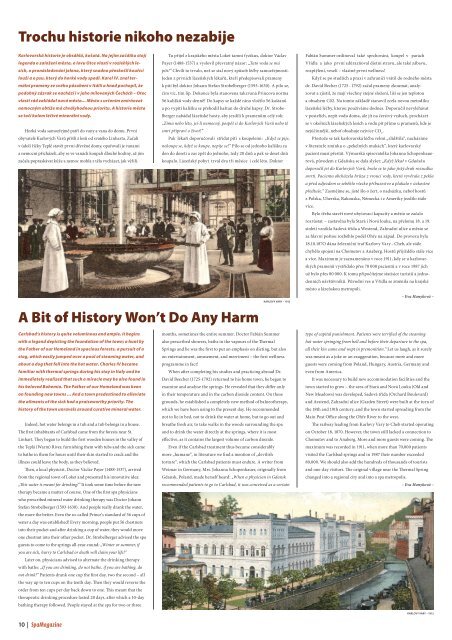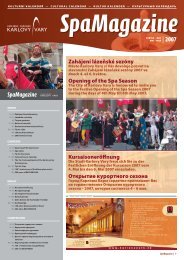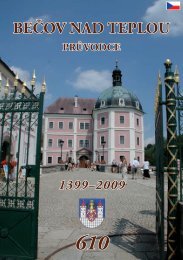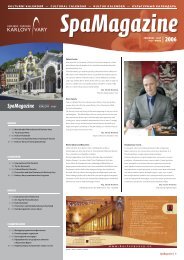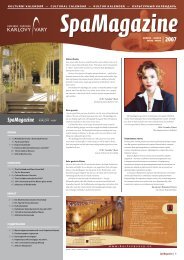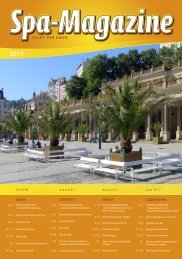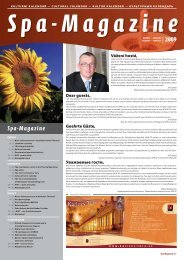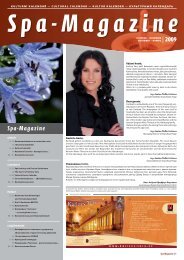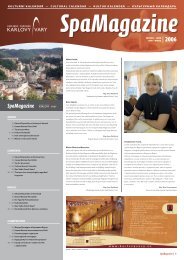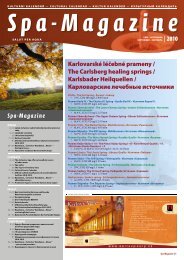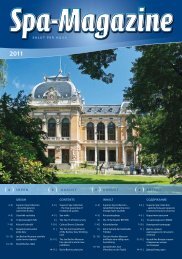SpaMagazine - Laverna Romana, sro
SpaMagazine - Laverna Romana, sro
SpaMagazine - Laverna Romana, sro
Erfolgreiche ePaper selbst erstellen
Machen Sie aus Ihren PDF Publikationen ein blätterbares Flipbook mit unserer einzigartigen Google optimierten e-Paper Software.
Trochu historie nikoho nezabije<br />
Karlovarská historie je obsáhlá, košatá. Na jejím začátku stojí<br />
legenda o založení města, o lovu Otce vlasti v rozlehlých le-<br />
sích, o pronásledování jelena, který snadno přeskočil kouřící<br />
louži a o psu, který do horké vody spadl. Karel IV. znal ter-<br />
mální prameny ze svého působení v Itálii a hned pochopil, že<br />
podobný zázrak se nachází i v jeho milovaných Čechách – Otec<br />
vlasti rád zakládal nová města... Město s určením zmírňovat<br />
nemocným obtíže má chvályhodnou prioritu. A historie města<br />
se točí kolem léčivé minerální vody.<br />
Horká voda samozřejmě patří do vany a vana do domu. První<br />
obyvatelé Karlových Varů přišli z lesů od svatého Linharta. Začali<br />
v údolí říčky Teplé stavět první dřevěné domy, opařovali je vanami<br />
a nemocní přicházeli, aby se ve vanách koupali dlouhé hodiny, až jim<br />
začala popraskávat kůže a nemoc mohla z těla vycházet, jak věřili.<br />
10 | <strong>SpaMagazine</strong><br />
Tu přijel z krajského města Loket tamní fyzikus, doktor Václav<br />
Payer (1488-1537) a vyslovil převratný názor: „Tato voda se má<br />
píti!“ Chvílí to trvalo, než se stal nový způsob léčby samozřejmostí.<br />
Jeden z prvních lázeňských lékařů, kteří předepisovali prameny<br />
k pití byl doktor Johann Stefan Strobelberger (1593-1630). A pilo se,<br />
čím víc, tím lip. Dokonce byla stanovena takzvaná Princova norma<br />
56 kalíšků vody denně! Do kapsy se každé ráno vložilo 56 kaštanů<br />
a po vypití kalíšku se přehodil kaštan do druhé kapsy. Dr. Strobe-<br />
lberger nabádal lázeňské hosty, aby jezdili k pramenům celý rok:<br />
„Zima nebo léto, jsi-li nemocný, pospěš si do Karlových Varů nebo tě<br />
smrt připraví o život!“<br />
Pak lékaři doporučovali střídat pití s koupelemi: „Když se pije,<br />
nekoupe se, když se koupe, nepije se!“ Pilo se od jednoho kalíšku za<br />
den do deseti a zas zpět do jednoho, tedy 20 dnů a pak se deset dnů<br />
koupalo. Lázeňský pobyt trval dva tři měsíce i celé léto. Doktor<br />
A Bit of History Won’t Do Any Harm<br />
Carlsbad’s history is quite voluminous and ample. It begins<br />
with a legend depicting the foundation of the town; a hunt by<br />
the Father of our Homeland in spacious forests, a pursuit of a<br />
stag, which easily jumped over a pool of steaming water, and<br />
about a dog that fell into the hot water. Charles IV became<br />
familiar with thermal springs during his stay in Italy and he<br />
immediately realized that such a miracle may be also found in<br />
his beloved Bohemia. The Father of our Homeland was keen<br />
on founding new towns ... And a town predestined to alleviate<br />
the ailments of the sick had a praiseworthy priority. The<br />
history of the town unravels around curative mineral water.<br />
Indeed, hot water belongs in a tub and a tub belongs in a house.<br />
The first inhabitants of Carlsbad came from the forests near St.<br />
Linhart. They began to build the first wooden houses in the valley of<br />
the Teplá (Warm) River, furnishing them with tubs and the sick came<br />
to bathe in them for hours until their skin started to crack and the<br />
illness could leave the body, as they believed.<br />
Then, a local physicist, Doctor Václav Payer (1488-1537), arrived<br />
from the regional town of Loket and presented his innovative idea:<br />
„This water is meant for drinking!“ It took some time before the new<br />
therapy became a matter of course. One of the first spa physicians<br />
who prescribed mineral water drinking therapy was Doctor Johann<br />
Stefan Strobelberger (1593-1630). And people really drank the water,<br />
the more the better. Even the so-called Prince‘s standard of 56 cups of<br />
water a day was established! Every morning, people put 56 chestnuts<br />
into their pocket and after drinking a cup of water, they would move<br />
one chestnut into their other pocket. Dr. Strobelberger advised the spa<br />
guests to come to the springs all-year-round: „Winter or summer, if<br />
you are sick, hurry to Carlsbad or death will claim your life!“<br />
Later on, physicians advised to alternate the drinking therapy<br />
with baths: „If you are drinking, do not bathe, if you are bathing, do<br />
not drink!“ Patients drank one cup the first day, two the second – all<br />
the way up to ten cups on the tenth day. Then they would reverse the<br />
order from ten cups per day back down to one. This meant that the<br />
therapeutic drinking procedure lasted 20 days, after which a 10-day<br />
bathing therapy followed. People stayed at the spa for two or three<br />
KARLOVY VARY – 1912<br />
months, sometimes the entire summer. Doctor Fabián Summer<br />
also prescribed showers, baths in the vapours of the Thermal<br />
Springs and he was the first to put an emphasis on dieting, but also<br />
on entertainment, amusement, and merriment – the first wellness<br />
programme in fact!<br />
When after completing his studies and practicing abroad Dr.<br />
David Beecher (1725-1792) returned to his home town, he began to<br />
examine and analyse the springs. He revealed that they differ only<br />
in their temperature and in the carbon dioxide content. On these<br />
grounds, he established a completely new method of balneotherapy,<br />
which we have been using to the present day. He recommended<br />
not to lie in bed, not to drink the water at home, but to go out and<br />
breathe fresh air, to take walks in the woods surrounding the spa<br />
and to drink the water directly at the springs, where it is most<br />
effective, as it contains the largest volume of carbon dioxide.<br />
Even if the Carlsbad treatment thus became considerably<br />
more „humane“, in literature we find a mention of „devilish<br />
torture“, which the Carlsbad patients must endure. A writer from<br />
Weimar in Germany, Mrs. Johanna Schopenhauer, originally from<br />
Gdansk, Poland, made herself heard: „When a physician in Gdansk<br />
recommended patients to go to Carlsbad, it was conceived as a certain<br />
Fabián Summer ordinoval také sprchování, koupel v parách<br />
Vřídla a jako první zdůrazňoval dietní stravu, ale také zábavu,<br />
rozptýlení, veselí – vlastně první wellness!<br />
Když se po studiích a praxi v zahraničí vrátil do rodného města<br />
dr. David Becher (1725 - 1792) začal prameny zkoumat, analy-<br />
zovat a zjistil, že mají všechny stejné složení, liší se jen teplotou<br />
a obsahem C02. Na tomto základě stanovil zcela novou metodiku<br />
lázeňské léčby, kterou používáme dodnes. Doporučil nevylehávat<br />
v postelích, nepít vodu doma, ale jít na čerstvý vzduch, procházet<br />
se v okolních lázeňských lesích a vodu pít přímo u pramenů, kde je<br />
nejúčinnější, neboť obsahuje nejvíce CO 2 .<br />
Přestože se tak karlovarská léčba velmi „zlidštila“, nacházíme<br />
v literatuře zmínku o „pekelných mukách“, které karlovarský<br />
pacient musí přestát. Výmarská spisovatelka Johanna Schopenhaue-<br />
rová, původem z Gdaňska se dala slyšet: „Když lékař v Gdaňsku<br />
doporučil jet do Karlových Varů, bralo se to jako jistý druh rozsudku<br />
smrti. Pacienta obcházela hrůza z vroucí vody, která vyvěrala z pekla<br />
a před odjezdem se seběhlo všecko příbuzestvo a plakalo v úzkostné<br />
předtuše.“ Zasmějme se, jistě šlo o žert, o nadsázku, neboť hostů<br />
z Polska, Uherska, Rakouska, Německa i z Ameriky jezdilo stále<br />
více.<br />
Bylo třeba stavět nové ubytovací kapacity a město se začalo<br />
rozrůstat – zastavěna byla Stará i Nová louka, na přelomu 18. a 19.<br />
století vznikla Sadová třída a Westend, Zahradní ulice a město se<br />
za hlavní poštou rozběhlo podél Ohře na západ. Do provozu byla<br />
18.10.187O dána železniční trať Karlovy Vary – Cheb, ale stále<br />
chybělo spojení na Chomutov a Anaberg. Hostů přijíždělo stále více<br />
a více. Maximum je zaznamenáno v roce 1911, kdy se u karlovar-<br />
ských pramenů vystřídalo přes 70 000 pacientů a v roce 1987 jich<br />
už bylo přes 80 000. K tomu připočítejme statisíce turistů a jedno-<br />
denních návštěvníků. Původní ves u Vřídla se změnila na krajské<br />
město a lázeňskou metropoli.<br />
– Eva Hanyková –<br />
type of capital punishment. Patients were terrified of the steaming<br />
hot water springing from hell and before their departure to the spa,<br />
all their kin came and wept in premonition.“ Let us laugh, as it surely<br />
was meant as a joke or an exaggeration, because more and more<br />
guests were coming from Poland, Hungary, Austria, Germany and<br />
even from America.<br />
It was necessary to build new accommodation facilities and the<br />
town started to grow – the area of Stará and Nová Louka (Old and<br />
New Meadows) was developed, Sadová třída (Orchard Boulevard)<br />
and Aestend, Zahradní ulice (Garden Street) were built at the turn of<br />
the 18th and 19th century, and the town started spreading from the<br />
Main Post Office along the Ohře River to the west.<br />
The railway leading from Karlovy Vary to Cheb started operating<br />
on October 18, 1870. However, the town still lacked a connection to<br />
Chomutov and to Anaberg. More and more guests were coming. The<br />
maximum was recorded in 1911, when more than 70,000 patients<br />
visited the Carlsbad springs and in 1987 their number exceeded<br />
80,000. We should also add the hundreds of thousands of tourists<br />
and one-day visitors. The original village near the Thermal Spring<br />
changed into a regional city and into a spa metropolis.<br />
– Eva Hanyková –<br />
KARLOVY VARY – 1912


